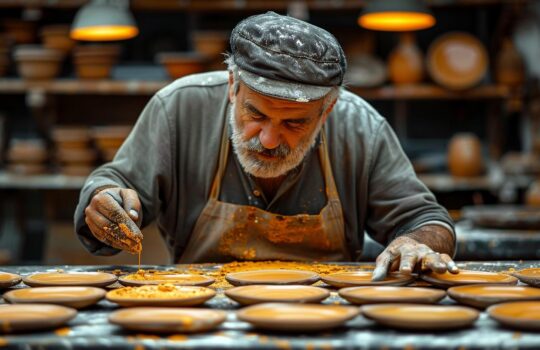The Art of Jewish Craftsmanship Through the Ages

Jewish craftsmanship, an integral part of the diverse tapestry of cultural heritage, has a rich legacy stretching back through the annals of history. Rooted deeply in tradition and faith, the art produced by Jewish artisans is not only a reflection of skilled workmanship but also a testament to their deep-seated cultural identity and resilience.
This article aims to illuminate the significance of Jewish craftsmanship within its historical context, examining how it has evolved while carrying forward traditions cherished by generations.
The communal spirit and religiosity inherent in Jewish life have long been channeled into the creation of meaningful artifacts. Throughout various epochs-from ancient times to the contemporary era-Jewish artists have contributed significantly to the fabric of human creativity. They’ve adeptly maneuvered societal shifts and adversities to maintain a continuous thread of artistic expression that honors their beliefs, heritage, and profound sense of community.
As we delve into this exploration across different eras and styles, we will uncover both the constant elements that define Jewish craftsmanship and the ways in which it has adapted over time. From significant architectural contributions during medieval times to modern interpretations influenced by broad ranging stylistic movements, this journey will disclose how each epoch’s unique circumstances shaped Jewish artisans’ responses through their creative endeavors-all while contributing distinctively precious additions to our collective cultural assets.
Ancient Origins
Jewish craftsmanship, defined by the cultural heritage and artistic expression of the Jewish people, dates back thousands of years. With roots steeped deeply in ancient traditions, Jewish artisans have contributed significantly to the fabric of historical artistry. This craft is tied to a rich legacy that has carried forward an identity and faith through tangible art forms.
The Bible serves as one of the earliest historical texts acknowledging the presence and importance of Jewish craftsmen. Artisans were highly regarded within their communities for their skills and played integral roles in constructing important religious articles and edifices.
Biblical descriptions tell us about skilled workers in metalworking, weaving, carving, and even perfume-making. Bezalel, a character mentioned in Exodus 31:1-5, is a prime example; he was appointed by God to lead the construction of the Tabernacle due to his mastery in working with various materials.
Materials and methods used by these ancient artisans were diverse and testify to an impressive level of expertise given the era’s technological constraints. For instance, metalworkers harnessed techniques such as forging, casting, engraving, and filigreeing to create intricate ceremonial objects out of bronze, silver, gold-and less frequently-iron. Weavers carefully crafted textiles for sacred uses employing natural dyes extracted from plants and insects to achieve vibrant colors.
| Craft | Description |
|---|---|
| Metalworking | Involving forging brass items like candlesticks or casting silver for use in rituals. |
| Weaving | Creating textiles for cloaks or curtains using materials like wool or linen. |
| Wood Carving | Fashioning practical items or decorative panels often with religious symbolism. |
| Stone masonry | Shaping stone for building altars or temples. |
These early references exemplify not only technical prowess but also underscore a significant feature of Jewish craftsmanship: its devotion to serving spiritual purposes. The construction of the Tabernacle-a mobile dwelling place for divine presence during the Israelites’ exodus-required precision and artistic excellence that reflected reverence for sacred practices. The biblical record details this process meticulously: from spun fine linens for vestments to fashioned gold cherubim atop the Ark of Covenant.
Jewish craftsmen took on these commendable projects often dictated by divine instruction which intertwined their talent with spiritual dedication-a theme recurrent throughout Jewish art history. In doing so they left behind an enduring testament not simply through physical artifacts but through contributions vividly described within historical scriptures which continue capturing imaginations today. This intersection between faith-driven motivation and material manifestation defines much uniquely about Jewish craftsmanship throughout antiquity.
Medieval Mastery
Throughout the medieval period, Jewish craftsmen made notably significant contributions to the fabric of society, despite facing profound limitations due to their faith and laws of the land. Fabricated under a myriad of restrains, jewish craftsmanship during this era stands testament to the indomitable spirit and rich cultural expression of these skilled individuals. Their works not only contributed to their own community’s needs but also played a role in influencing broader artistic and architectural advancements.
During the Middle Ages, Jews were often barred from joining guilds or practising certain trades because of prevailing societal prejudices and restrictive local laws. Nonetheless, many found niches where they could express their talents.
Particularly in Islamic countries, Jewish artisans were integral contributors to the ornate designs seen in architecture and manuscripts. Meanwhile, in Christian lands, restrictions were heavier yet some managed to excel as goldsmiths and silversmiths, producing religious artefacts that have now become precious treasures not only for their technical prowess but also for their historical value.
| Region | Contribution |
|---|---|
| Islamic Countries | Manuscript illumination, architectural design elements |
| Christian Europe | Jewelry making, coin minting, metalwork for religious artifacts |
Despite operating within a framework of oppression and marginalization during medieval times, Jewish artisans found ways to incorporate elements of the Romanesque and Gothic styles into their work while still preserving unique features of Jewish identity. This synthesis was facilitated by Jews being spread across diverse territories thus leading them to adapt motifs from different cultures into their artistry.
The synagogue architecture from this period speaks volumes about this amalgamation with features borrowed from prevailing European trends yet integrated subtly with iconic Judaic symbols like the Star of David or Hebrew calligraphy.
From surviving examples like manuscripts adorned with intricate miniatures painted by Jewish artists or tombs embellished with fine carvings crafted by anonymous stonemasons whose faith lived passionately beneath each chiseled feature – all bear witness to an enduring artistic tradition amid adversity. These invaluable creations present not only untold stories woven through time but illustrate how even amidst limitations Jews continued using artisanal practices as a formative way of expressing both communal identity and personal devotion.

Embracing the Diaspora
As the Jewish people dispersed across the globe, their craftsmanship naturally evolved, intricately weaving in elements of local cultures they encountered. This diaspora did not dilute the essence of Jewish artistic tradition; rather, it expanded and enriched it.
As artisans settled in new lands-from Eastern Europe to North Africa, from the Middle East to the Americas-they adapted local materials and styles into their craft. Such a fusion of diverse artistic languages allowed for a unique expression of identity that was both unmistakably Jewish and distinctively influenced by their host communities.
This cross-cultural exchange is evident in various realms of jewish craftsmanship, with palpable distinctions arising as a result. In Islamic lands, for example, Jewish silversmiths might have engraved Hebrew lettering onto ornamental objects while employing arabesque patterns typical of Islamic art.
Elsewhere, in places such as Poland or Russia, one could find wooden synagogues constructed by Jewish carpenters embracing motifs and woodworking techniques traditional to Slavic architecture. By embracing these regional characteristics and blending them with traditional motifs-like the Star of David or menorah-Jewish craftsmen were able to produce works that resonated deeply with both their heritage and their surroundings.
This diversity manifests itself vividly in decorative arts such as textiles and metalwork. Textiles fashioned by Jews in Morocco bore vibrant colors and geometric patterns similar those found in Berber design, yet featuring Hebrew inscriptions. Meanwhile, Jews residing in Germany may have produced ceremonial silverware with gothic influences ingrained within its form.
Beyond mere aesthetics, these items reflected a deep-seated adherence to ritual commandments and celebrations central to Jewish life; every piece crafted served not just as an object of beauty but also as a functional part of religious observance. The interchange between global inspirations and sacred traditions underscores how Jewish craftsmen successfully preserved the core tenets of their faith while contributing uniquely to the broader tapestry of world artisanship.
Jewish Craftsmanship in the Modern World
Jewish craftsmanship, deeply embedded within the cultural heritage of the Jewish people, has long been shaped by the challenges and advances of history. With the advent of modernity and transitions into contemporary society, Jewish artisans found themselves at a unique crossroads between tradition and innovation.
The Arts and Crafts movement of the late 19th and early 20th centuries, with its emphasis on hand-made quality and decorative arts, significantly impacted Jewish craftsmen. Many embraced this aesthetic, which resonated with their own cultural appreciations for intricate details and meticulous workmanship inherent in their tradition.
The shift to industrialization also presented opportunities to recontextualize longstanding forms of Jewish artistry. Craftsmen who had honed ancient practices for generations began experimenting with new mediums and technologies.
Innovations in materials and techniques allowed these artists to play an important role in keeping their traditions vibrant while appealing to a more universal audience. One could find menorahs artistically fused from metal using modern welding methods or Torah arks splendidly crafted from exotic woods brought by global trade-all testifying to a fresh yet loyal interpretation of historical craft.
Contemporary Jewish artists continue this proud lineage by preserving traditional crafts’ distinctive characteristics while exploring progressive expressions. These modern artisans represent an array of disciplines including glassblowing, textile art, metalwork, jewelry design, calligraphy, painting, sculpture, and more-each infusing their pieces with thematic components steeped in Judaic culture. Artists such as Mordechai Rosenstein intertwine rich color palettes with Hebrew calligraphy to create visually arresting compositions that narrate biblical stories or verses imbued with spiritual significance.
Others like Tobi Kahn have gained recognition for abstract works that embody meditative qualities reflective of Judaic themes without explicit religious iconography. Their artworks not only contribute significantly to contemporary art but proudly declare the enduring narrative of jewish craftsmanship adapting through time while honoring its treasured roots.
Recognizing the Artisans
Jewish craftsmanship is a tapestry woven through time with threads of skill, perseverance, and cultural expression. At the heart of this artistic heritage stand the artisans themselves, individuals whose works have not only captivated their contemporaries but have also left an indelible mark on history. The biographies of these craftsmen and women offer inspiring tales that combine personal fortitude with creative genius. Reflecting upon a few notable figures allows us to appreciate the vast spectrum encompassed within Jewish artistry.
One luminary in this rich history is Boris Schatz, often referred to as the “father of Israeli art,” who founded the Bezalel Academy of Arts and Design in Jerusalem in 1906. Schatz advocated for the combination of traditional Jewish motifs with contemporary artistic techniques, leading to a renaissance in Jewish visual culture. Under his guidance, students excelled in metalwork, embroidery, painting, and more – all while imbuing their creations with elements drawn from Jewish heritage.
- Solomon Aaron Beman was renowned for his exquisite synagogue architecture which harmoniously blended traditional motifs with modern styles.
- Lilien Solomon, an artist known for her intricate jewelry designs, intertwined symbols such as the Star of David and Chai with precious metals and stones, creating pieces that are cherished to this day for their spiritual resonance.
- Ephraim Moses Lilien was a pioneering printmaker whose works depicted biblical scenes and Zionist themes; he was pivotal in shaping early Zionist visual iconography.
Apart from individual accolades and achievements, what stands out about these artists is how their work served as poignant statements about identity during times when Jews were seeking both national renewal and cultural preservation. Their masterpieces speak not merely to an audience of connoisseurs but also resonate deeply within communities around the world for whom these items encapsulate both beauty and belonging.

The legacy left by legendary silversmiths like Ilya Schor extends beyond mere aesthetics; they reveal aspects of everyday life entwined with religious practice-hammered silver kiddush cups passed down through generations bear testimony to this enduring craft tradition. Another prominent figure was Hedwig Grossman Jahoda who revolutionized textile design by incorporating traditional techniques into cutting-edge fashion.
These stories highlight the profound impact Jewish artisans have had across varied fields – from metalwork to textiles. They demonstrate resilience in preserving time-honored practices while simultaneously pushing boundaries within their crafts. These craftsmen and women did not merely create tangible objects; they wove together strands of cultural memory that continue to inspire admiration for jewish craftsmanship far beyond its intrinsic material value.
The Spiritual Essence of Jewish Craftsmanship
Jewish craftsmanship goes beyond the mere creation of tangible objects; it intertwines deeply with spirituality and religious practices. The enduring nature of Jewish art is not just a testament to the skill and creativity of its artisans but also reflects the beliefs, traditions, and values held sacred throughout centuries.
Jewish Symbols and Motifs
One of the defining characteristics of Jewish artistry is the recurrent use of symbols and motifs that carry significant spiritual meanings. Common symbols include the Star of David, which represents divine protection and is associated with King David, and the menorah, reflecting wisdom and divine light. Other motifs like the Hamsa hand symbolize protection from evil eyes, while pomegranates signify abundance and fertility.
These symbols are often incorporated into ceremonial objects, architecture, textiles, and jewelry. Each piece serves more than an aesthetic purpose; they act as conduits for meditation, reflection, or protection-each crafted with intentionality that deepens one’s connection to their faith.
The Role of Intention in Craftsmanship
In Jewish tradition, there is a concept known as ‘kavanah’, which refers to the intention or focus one brings to a spiritual practice. This principle plays a pivotal role in craftsmanship because it implies that during the creation process artisans should maintain awareness and purpose aligned with Jewish teachings.
Whether crafting items for worship such as Tallits (prayer shawls), Kiddush cups used during Sabbath ceremonies or even etching inscriptions on tombstones-the intent behind their work adds a sacred dimension transforming mundane materials into spiritually charged artifacts.
The mindful approach taken by artists means every stroke, carve or weave contains prayerful contemplation-instilling pieces with personal devotion that can be sensed by those who interact with them. As such, jewish craftsmanship isn’t simply about creating objects but rather about infusing creations with spirituality that can be passed down through generations.
Judaism’s Rich Iconography
Apart from symbols directly linked to religious observance or protection, Jewish art includes rich iconography derived from biblical texts – such as images telling stories from Torah or depicting prophets, sages and historical figures central to Jewish heritage. Calligraphy also features prominently in traditional artistry; Hebrew script itself being considered an art form through meticulously created Torah scrolls so textured they seem almost alive when unfurled during services.
Additionally, decorative elements like elaborately carved arc doors holding Torahs within synagogues act not only as storage spaces but sacred gateways harbouring God’s word-designed intricately to reflect reverence towards these scrolls. Such detailed attention given to iconography embodies respect towards religion while allowing both artists and observers alike to engage with spirituality on a profound level through visual representation-one where history is continually celebrated through each brushstroke engrained within timeless artistic realms.
Preserving Tradition
Jewish craftsmanship, with its rich historical legacy and unique cultural significance, faces the dual challenge of preservation and innovation as we move further into the 21st century. This section outlines how these traditions are being upheld and adapted to remain relevant in our rapidly changing world.
The Role of Jewish Artisan Guilds and Societies
To safeguard the future of Jewish craftsmanship, various guilds and societies have been instrumental in gathering artisans who share a dedication to their heritage crafts. These establishments often serve multiple functions; they are repositories for ancient techniques, centers for education, and platforms that promote Jewish artisans.
Additionally, guilds can provide financial support or grants enabling artists to continue their work without compromising on the quality or authenticity that characterize traditional Jewish art forms. Through organized workshops, exhibitions, and mentorship programs, such guilds ensure the transfer of knowledge from one generation to the next remains unbroken.
Educational Programs and Cultural Initiatives
Education is critical when it comes to preserving cultural practices like Jewish craftsmanship. Schools dedicated to teaching traditional arts have been set up globally. These institutions offer formal training in skills ranging from metalwork inspired by ancient designs to contemporary interpretations of textile weaving.
Cultural initiatives are also pivotal as they encourage public interest and understanding of the historical significance behind these crafts. Efforts include festivals celebrating Jewish artistry where craftspeople can showcase their creations while engaging directly with communities, thereby fostering an appreciation that transcends religious or ethnic boundaries.
Integrating Technology With Traditional Techniques
In a modern context where technology impacts all aspects of life, traditional crafts may seem at risk of becoming obsolete. However, innovative artisans are finding ways to integrate new technologies with age-old techniques-creating a synergy between the past and present. Digital tools enable more intricate design processes or may even aid in replicating historical artifacts with precision previously unachievable by hand alone.
Simultaneously, technology facilitates reaching broader audiences through online marketplaces where people worldwide can purchase original works of Jewish artistry. Social media platforms allow craftsmen to share their processes and finished works, thus educating viewers about the meticulous labor and cultural stories embedded within each piece.
By combining reverence for history with present-day possibilities, contemporary proponents of jewish craftsmanship pave a promising path toward ensuring its perpetuity-a fusion where heritage craftsmanship finds newfound relevance amidst an ever-evolving artistic landscape.

Conclusion
The enduring nature of Jewish craftsmanship is a testament to a cultural narrative that has been woven through the tapestry of history. From the intricate designs crafted by ancient biblical craftsmen to the contemporary creations that continue to evolve today, Jewish artistry remains tightly bound to its cultural and religious roots while embracing change and innovation.
The beauty and significance of these traditions not only lie in their aesthetic appeal but also in their role as vessels for preserving Jewish identity across time and space.
Across continents and throughout the centuries, Jewish craftsmen have faced myriad challenges, from persecution to assimilation pressures. Nevertheless, they persisted, ensuring their techniques, styles, and iconography survived.
Their resilience speaks volumes about their commitment not just to their craft but also to their heritage. Modern-day supporters and practitioners of Jewish art forms shoulder an important responsibility-to engage with these traditions actively and thoughtfully so as to ensure they are passed on to subsequent generations who will, hopefully, find in them as much pride and purpose as those who came before.
Reflecting on the cultural and historical impact of Jewish craftsmanship underscores its significant contribution to global artistic heritage. The unique blend of spirituality, tradition, and personal expression found in these works cannot be overstated.
Today’s society benefits greatly when it recognizes the value that diversity brings-in this case, how jewish craftsmanship enriches our world with stories of faith, endurance, and creativity. In supporting such diverse expressions of human ingenuity, we not only honor past artisans but also help sow seeds for the artists of tomorrow whose work will continue narrating the multifaceted story of the Jewish people through engaging shapes, colors, materials-and most importantly-meaningful connections with our shared past.
Frequently Asked Questions
What Are the Traditional Crafts of Israel?
The traditional crafts of Israel include a variety of artistic expressions rooted in cultural and religious practices. Among these are Judaica, which comprises items used in Jewish religious rituals such as menorahs, mezuzot, and kiddush cups. Israel is also known for its ceramics and pottery that often feature biblical scenes and inscriptions.
Textile crafts like tallitot (prayer shawls) and tapestries are common, with some incorporating ancient weaving techniques passed down through generations. In addition, jewelry making using gold, silver, and precious stones has been practiced for centuries reflecting both contemporary designs and motifs derived from Jewish history.
What Are Some Examples of Jewish Art?
Jewish art encompasses various forms ranging from biblical illustrations to contemporary abstract pieces that incorporate Jewish symbols or themes. Historical examples include illuminated manuscripts like the Haggadah with detailed paintings that narrate the story of Passover; ancient mosaics found in synagogues depicting religious icons; Marc Chagall’s stained glass windows; modern bronze sculptures by artists such as Boris Schatz; and vivid paintings that visualize traditions or biblical narratives.
These artworks serve not only as aesthetic creations but also as mediums preserving cultural narratives.
What Do Jews Believe About Creation?
Jews generally believe that creation was an intentional act by God who created the world out of nothingness in six days, resting on the seventh day – an event commemorated weekly through Shabbat observances. This account is detailed in Genesis, the first book of the Hebrew Bible (Tanakh).
While interpretations may vary among different Jewish sects—from literal to allegorical readings—the central tenet holds that God is singularly responsible for creating the universe with purpose and intentionality.
What Makes Jewish Art Jewish?
Jewish art is considered Jewish not just because of its subject matter or symbolism but because it often incorporates elements of religious tradition, historical experiences or reflects on aspects specific to Jewish life and values.
Art becomes distinctly Jewish when it maintains a connection to Judaic concepts—whether through texts, rituals or communal histories—and consequently resonates with collective memories and stories central to the identity of its audience.
What Art Did the Israelites Make?
The Israelites produced a range of artistic works despite prohibitions against creating graven images which limited visual arts development within certain periods of their ancient society.
Archaeological findings suggest they engaged in crafts such as weaving patterned textiles; metallurgy where they made intricately designed ceremonial objects including incense altars; pottery adorned with geometric patterns or inscriptions; and olive oil lamps frequently discovered among ruins.
What Art Is Israel Known For?
Israel is widely recognized for its eclectic mix of contemporary art along with traditional crafts deeply influenced by its diverse culture comprising immigrants from over 120 countries alongside ancient local heritage practices.
Visual arts thrive here achieving international acclaim particularly Israeli painting and sculpture featuring pioneering artists like Yaacov Agam who’s known for kinetic art reflecting Zionist themes while leading contemporary artists continue pushing boundaries across new media installations encompassing digital art forms emphasizing social-political critique pertinent to Israeli society.
What Are the Sacred Objects of Israel?
Sacred objects rooted in Biblical times continue holding profound significance within Israeli culture ranging from religious artifacts to archaeological treasures lending insight into ancestral faith practices spanning millenia apart from these tangible artifacts places hold sacred value namely historic sites Western Wall Jerusalem remnant Second Temple Dome Rock housing foundation stone world believed center creation thus landscapes objects merge symbolically connecting present-day worshipers scriptural heritage pivotal within Israeli spirituality history preservation efforts demonstrate ongoing commitment towards safeguarding invaluable legacy posterity.
What Products Are Popular in Israel?
A wide array products gained popularity thriving categories agricultural exports particularly citrus fruits olives compendium Mediterranean cuisine dairy goods cultivated through advanced farming techniques add flourishing startup scene Israel generates high-tech gadgets tools vastly improving everyday experiences lastly beauty wellness products containing minerals Dead Sea revered therapeutic qualities alongside fashion accessories stand testament industrious innovative nature country continually expands diverse offering goods fulfill global demand diverse sectors economy.





